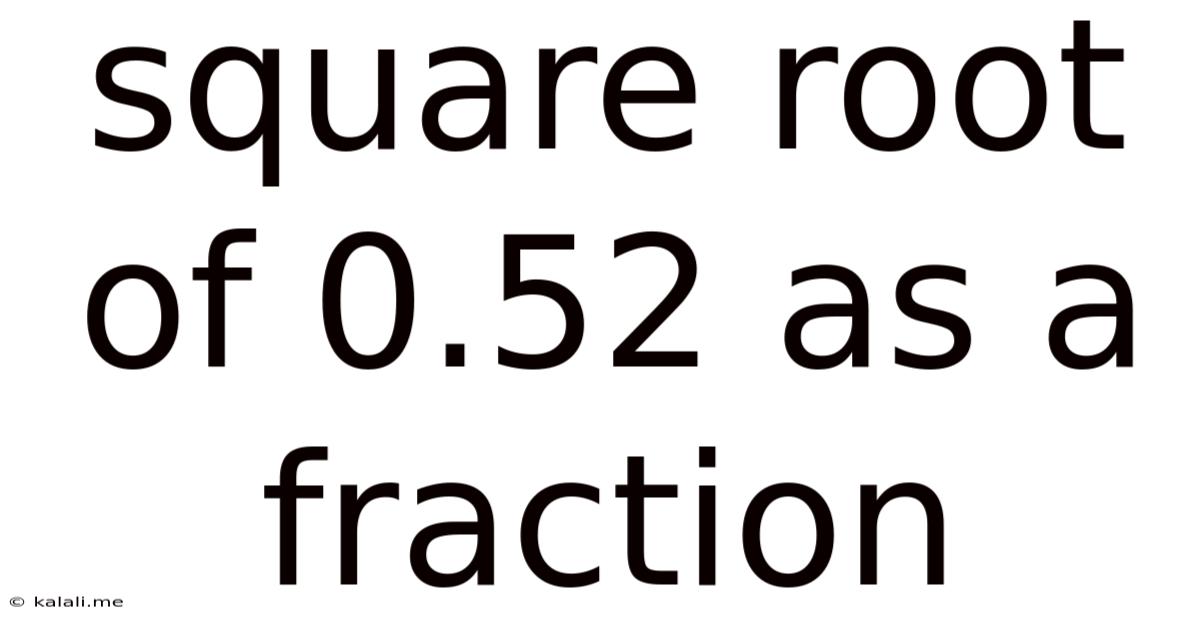Square Root Of 0.52 As A Fraction
Kalali
Jul 29, 2025 · 4 min read

Table of Contents
Finding the Square Root of 0.52 as a Fraction: A Deep Dive into Mathematical Concepts
This article explores the process of finding the square root of 0.52 as a fraction, delving into the underlying mathematical concepts and providing a step-by-step guide. We'll cover various methods, discuss the limitations of each, and ultimately arrive at a simplified fractional representation. Understanding this process improves your grasp of fractions, decimals, and square roots – essential concepts in mathematics and various fields.
Meta Description: Learn how to calculate the square root of 0.52 as a fraction. This comprehensive guide explores different methods, addresses limitations, and provides a step-by-step solution, enhancing your understanding of mathematical concepts.
Understanding the Problem: Square Roots and Fractions
Before we embark on calculating the square root of 0.52 as a fraction, let's refresh our understanding of the key terms.
-
Square Root: A square root of a number is a value that, when multiplied by itself, gives the original number. For example, the square root of 9 is 3 because 3 * 3 = 9. The square root of a number 'x' is denoted as √x.
-
Fraction: A fraction represents a part of a whole. It's expressed as a ratio of two integers, a numerator (top number) and a denominator (bottom number). For instance, 1/2 represents one-half.
Our goal is to find a fraction a/b such that (a/b) * (a/b) = 0.52. This is not a simple perfect square, meaning we won't find a neat, easily discernible fractional answer. We need to employ methods that approximate the solution or convert the decimal to a more manageable fraction before calculating the square root.
Method 1: Converting Decimal to Fraction
The first approach involves converting the decimal 0.52 into a fraction. This simplifies the subsequent square root calculation.
-
Express the decimal as a fraction: 0.52 can be written as 52/100.
-
Simplify the fraction: Both the numerator and denominator are divisible by 4. Simplifying, we get 13/25.
-
Find the square root of the fraction: Now we need to find √(13/25). The square root of a fraction is the square root of the numerator divided by the square root of the denominator. Therefore: √(13/25) = √13 / √25 = √13 / 5
-
Approximating √13: Since 13 isn't a perfect square, we need to approximate its square root. We know that √13 is between √9 (which is 3) and √16 (which is 4). Using a calculator, we find that √13 ≈ 3.6056.
-
Final Approximation: Substituting the approximate value of √13, we get (3.6056) / 5 ≈ 0.7211. This is an approximate decimal representation of the square root. To express this as a fraction, we can use continued fractions or other approximation methods, but this won't yield a simple, exact fraction.
Method 2: Using a Calculator and Converting to Fraction (Approximation)
Modern calculators provide a direct way to calculate square roots.
-
Calculate the square root: Using a calculator, find the square root of 0.52: √0.52 ≈ 0.72111.
-
Convert the decimal to a fraction (approximation): Converting this decimal to a fraction requires approximation. One way is to express the decimal as a fraction with a power of 10 as the denominator. For instance, 0.72111 can be approximated as 72111/100000. This fraction, however, is not simplified and can be further approximated for simplicity. This method, while fast, results in an approximate fraction and doesn't guarantee a simple, easily manageable fraction.
Method 3: Continued Fractions (Advanced Approach)
Continued fractions offer a more sophisticated way to represent irrational numbers, like the square root of 13, as a sequence of fractions that converge to the actual value. This method requires a deeper understanding of mathematical concepts. The details are beyond the scope of this introductory article, but it's worth noting as a more advanced technique for accurate approximations.
Limitations and Considerations
It's crucial to understand the limitations of these methods:
-
Approximation: Since 0.52 isn't a perfect square, obtaining an exact fractional representation is impossible. All methods presented provide approximations.
-
Accuracy: The accuracy of the approximation depends on the method used and the level of precision required. Calculator methods might offer high precision, but converting the resulting decimal to a fraction introduces approximation errors.
-
Complexity: Methods like continued fractions are mathematically rigorous but can be complex and time-consuming for beginners.
Conclusion: Balancing Accuracy and Simplicity
Finding the square root of 0.52 as a fraction requires a balance between accuracy and simplicity. While an exact fractional representation is unattainable, we can obtain reasonably accurate approximations using various methods. The choice of method depends on the required precision and the user's mathematical background. For quick approximations, a calculator combined with a conversion to a fraction is suitable. For a more in-depth understanding, exploring the continued fraction method might be beneficial. Remember that all results will be approximations due to the nature of the square root of a non-perfect square. Understanding the limitations of each method is key to interpreting the results accurately. This exploration highlights the interconnectedness of different mathematical concepts and the various techniques available to solve seemingly simple problems. Further exploration into these concepts will provide a deeper understanding of numerical analysis and approximation techniques.
Latest Posts
Latest Posts
-
How Many Pounds In 2 Cubic Feet Of Mulch
Jul 30, 2025
-
How Many Cups Are In A Cool Whip Container
Jul 30, 2025
-
1 Syllable Words That Start With S
Jul 30, 2025
-
How Many Sq Ft Is 34 Acres
Jul 30, 2025
-
How Much Does A Full Concrete Truck Weigh
Jul 30, 2025
Related Post
Thank you for visiting our website which covers about Square Root Of 0.52 As A Fraction . We hope the information provided has been useful to you. Feel free to contact us if you have any questions or need further assistance. See you next time and don't miss to bookmark.